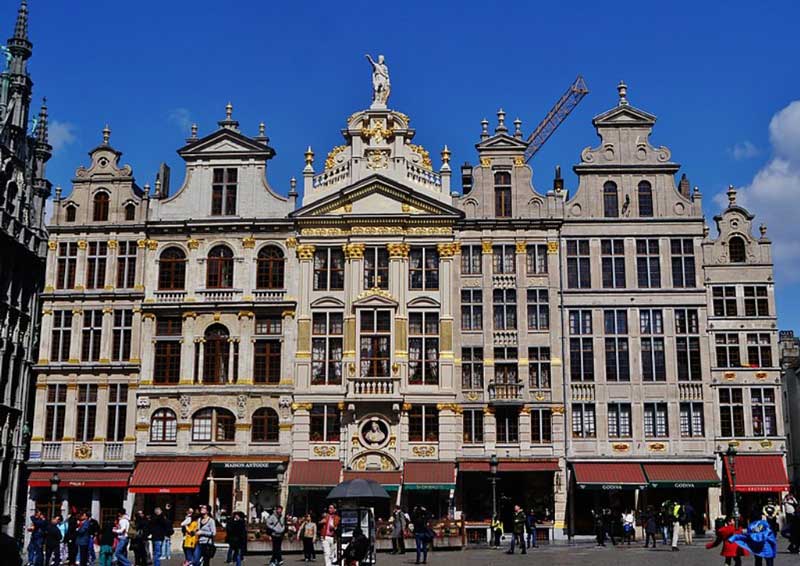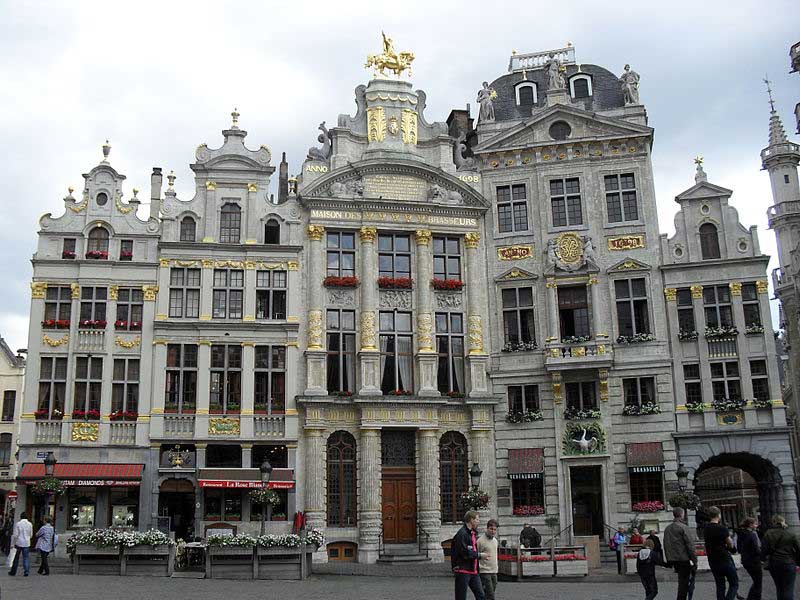
The Grand Place or The Grand Square in English, also known as the Grote Markt, is the central square of Brussels, the Capital City of Belgium, located at the heart of the Old Town. Measuring 223 by 361 feet (68 by 110 m) and surrounded by the exuberantly ornate guild houses of the 17th-century, it is perhaps the best single place to get a feeling of Old Europe. Enlisted in UNESCO World Heritage Site since 1998 and considered one of the most beautiful squares in Europe, the Grand Place is the most important tourist destination and most memorable landmark in Brussels. Apart from the imposing Town Hall or Hôtel de Ville on its south and the ornate King’s House or Maison du Roi on the north, the Grote Markt is lined with several guild houses and a few private houses.
By the end of the 11th-century, an open-air marketplace was set up on a dried-up marsh near the fort, located on Saint-Géry Island, known as Nedermerckt, meaning the Lower Market. Much later, at the beginning of the 13th-century, three indoor markets, a meat market, a bread market, and a cloth market, were built on the northern edge of the present Grand Place. With the rise of importance of the local merchants and tradesmen among the nobility, the condition of the Grand Place started to improve from the 14th-century, when the city of Brussels ordered the construction of a large indoor cloth market. During that time, several buildings that clogged the square were also demolished to formally define its edges.

The Gothic building of the Town Hall, the only remaining medieval building in the area, was built on the south side of the Grand Place in stages between 1401 and 1455 and accommodated the municipal authorities of the city.
Above the roof of the Town Hall, its 315 feet (96 m) tall square tower body narrows to a lavishly pinnacled octagonal openwork, and a 16 feet (5 m) tall gilt metal statue of Saint Michael, the patron saint of Brussels, slaying a demon, stands at its summit. The façade of the building is decorated with numerous statues representing nobles, saints, and allegorical figures. However, the current sculptures are only reproductions as the originals were shifted to the King’s House across the Grand Place.

Unfortunately, the Town Hall was almost destroyed due to the massive bombardment by the French army on 13 August 1695, and the resulting fire completely gutted the building, consuming its archives and the invaluable art collections. While the interior was soon rebuilt, two additional rear wings were also added, transforming the L-shaped building into a quadrilateral, along with an inner courtyard. However, it underwent several restoration campaigns throughout the 19th century, when the interior halls were replenished with tapestries, paintings, and sculptures, largely representing subjects of importance in local and regional history.

During the 12th-century the King’s House was a wooden structure, where bread was sold, and was known as Broodhuis in Dutch, which stands for the Bread House. It was replaced by a stone building, constructed between 1504 and 1536, across the Town Hall on the site of the first cloth and bread markets, which was named the Duke’s House, and housed the administrative services of the Duke of Brabant. Later, when the duke became the King of Spain, the building was renamed the King’s House, although no king ever lived there. Together with the Town Building, the King’s House also suffered extreme damage during the French attack in 1695, and was almost rebuilt.
After the second restoration in 1767, it was reconstructed in 1868 by architect Victor Jamaer, who gave it the current neo-Gothic form, added two galleries and a central tower, apart from decorating the façade with statues and other decorations. During that time, a new wing in Flemish neo-Renaissance architectural style was also added at the rear of the building. Since 1887 the King’s House has become the home of the Brussels City Museum, featuring more than 7,000 items, which include artifacts, paintings, and tapestries, related to the history of Brussels.

The guild houses and the few private houses that lined on both sides of the Grote Markt were mainly constructed after the French attack in 1695. With strongly structured facades, rich sculptural decorations, and lavishly designed gables, the triangular upper parts of the walls at the end of a ridged roof, those buildings are evidently based on Italian Baroque style with significant Flemish influence.

The Grand Place witnessed a tragic event in 1523, when Henri Voes and Jean Van Eschen, the first Protestant martyrs, were burned alive in the square by the Holy Inquisition. Later, the Counts of Egmont and Horn were beheaded in front of the Broodhuis on 5 June 1568 for criticizing the policies of King Philip II, which triggered the armed revolt against the Spanish Habsburg rule, led by William of Orange.

At the onset of the First World War, the Grand Place was flooded with refugees, and the Town Hall was used as a makeshift hospital for the military and civilian casualties. The occupying German army took hold of the Grand Place at 2 pm on 20 August 1914, hoisted a German flag on the left side of the Town Hall, and set up field kitchens. Although the Grand Place stopped serving as a market on 19 November 1959, it is still popularly called the Grote Markt or the Grand Market by the locals. During the 1960, it served as a parking lot, which was subsequently removed in 1972 due to public demand. However, car traffic continued to pass through the square until 1990, when it was declared a pedestrian zone.

Today, the historic Grand Square in Brussels, lined with luxuriously ornate guild houses and equipped with lots of outdoor cafes, is always filled with locals and tourists alike. Concerts and musical performances are organized all through the year on the huge cobblestone arena for the entertainment of the public.
